The Integrated Disease Surveillance and Response Technical Guideline (IDSR TG) was developed in 2001 by the World Health Organization (WHO), to improve the capability for countries to detect and respond to 40 IDSR priority diseases. Taking into cognizance the changing epidemiological trends, the IDSR TG had undergone two revisions (2010 and 2018) and adaptations by WHO-AFRO. In the face of current public health threats and as a form of continuous improvement process, the Nigeria Centre for Disease Control (NCDC) in conjunction with key stakeholders have also carried out two in-country revisions and adaptations (2013 and 2019). The most recent revision of the IDSR TG was carried out in August 2019.
2. Consolidate all the reviewed and adapted sections of IDSR guidelines into one document before validation meeting
3. Validate the guideline by accepting and adopting all the changes and modifications made
Widely attended by experts from national institutions and development partners, the review workshop provided a unique opportunity to brainstorm on the critical ways to improve the current IDSR TG, bearing in mind the evolving public health challenges. Some of the partners in attendance were the representatives from the relevant national institutions, and development partners such as WHO, UNICEF, United States CDC, Public Health England, Africa Field Epidemiology Network, Resolve to Save Lives, University of Maryland (Baltimore) etc.
With increasing detection of diseases such as monkeypox and yellow fever in Nigeria, it is anticipated that the guideline when completed would support the use of evidence-based strategies for disease control.
Disease surveillance is critical, from local government to state and federal levels. It is critical that relevant stakeholders show high level of commitment and provide resources for the implementation of IDSR in Nigeria.
Summary of Incidents
Ongoing Incidents are defined as confirmed cases where a national EOC or equivalent has been activated.
Other incidents are those confirmed cases for which EOC is not activated
Notes
1. Information for this disease was retrieved from the Technical Working Group and Situation Reports
2. Case Fatality Rate (CFR) for this disease is reported for confirmed cases only
3. Information for this disease was retrieved from IDSR 002 data
4. CFR for this disease is reported for total cases i.e. suspected + confirmed
5. Information for sentinel influenza was retrieved from the laboratory
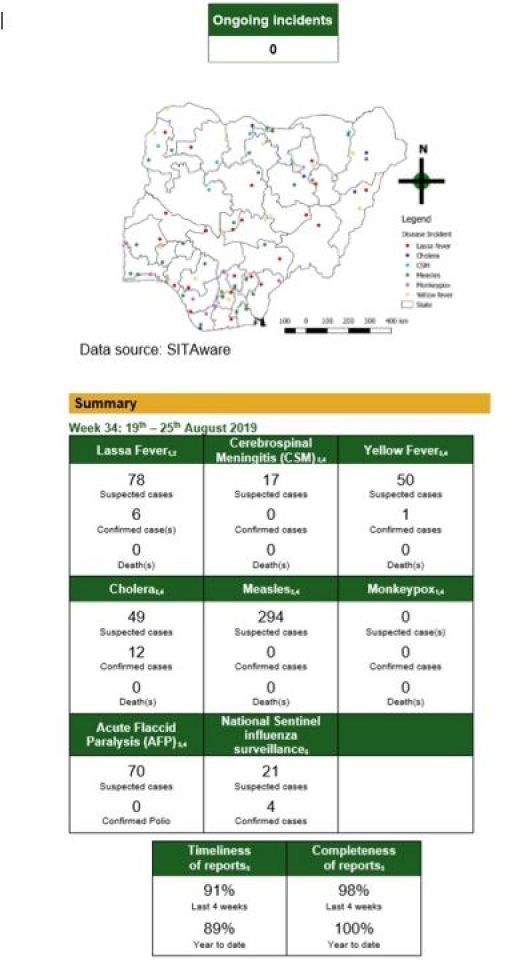
Lassa Fever
Key points
• There were 78 suspected cases of Lassa Fever (LF) reported from 16 LGAs in 13 states (Edo – 51, Ondo – 9, Ebonyi – 5, Bauchi – 4, Nasarawa – 1, Taraba – 1, Kwara – 1, Gombe – 1, Kaduna – 1, Kogi – 1, Delta – 1, Rivers – 1 & Cross River - 1). There were six confirmed cases and no death was recorded
• In the reporting, one new health care worker was infected in Ebonyi state. A total of 19 health care workers have been infected since the onset of the outbreak
Actions
To date:
• National LF multi-partner, multi-sectoral Technical Working Group (TWG) continues to coordinate the response activities at all levels
• Implementation of targeted risk communication and enhanced surveillance activities in affected states
Planned:
• Conduct a National After Action Review (AAR) retreat
• LF treatment centres assessment visit to Bauchi and Plateau states
• Finalise LF psychosocial guideline
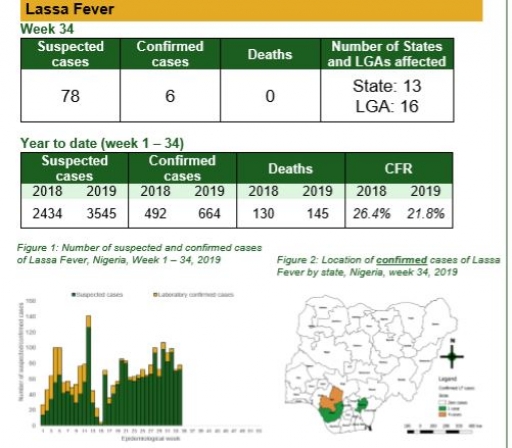
Cerebrospinal Meningitis (CSM)
Key points
• There were 17 suspected cases of Cerebrospinal Meningitis reported from nine LGAs in five states (Borno - 1, Ekiti – 1, Katsina – 12, Nasarawa – 1, Plateau - 2). None was laboratory confirmed and no death was recorded
Actions
To date:
• The National CSM TWG meets weekly to review reports from states and plan appropriately
Planned:
• Conduct AAR
• Harmonise surveillance and laboratory data
• Conduct case and data management training in Sokoto state from 26th – 28th September 2019
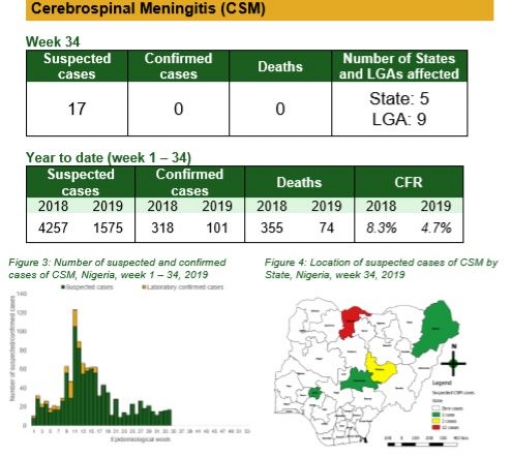
Yellow Fever
Key points
There were 50 suspected cases of Yellow Fever reported from 40 LGAs in 16 states. There was one confirmed case and no death was recorded
Actions
To date:
• The multiagency YF TWG is coordinating national response activities
• The Ebonyi and Katsina states Incident Coordination Centres are leading the outbreak investigation with support from the National team (NCDC) and WHO
• A Rapid Response Team (RRT) deployed to Bauchi state to assess the outbreak
• Three new laboratories added to the Yellow fever laboratory network
Planned:
• Reactive mass vaccination campaign in the eight selected LGAs in Ebonyi state is proposed for September 2019
• Scale up risk communication activities, advisories and press release on YF outbreak.
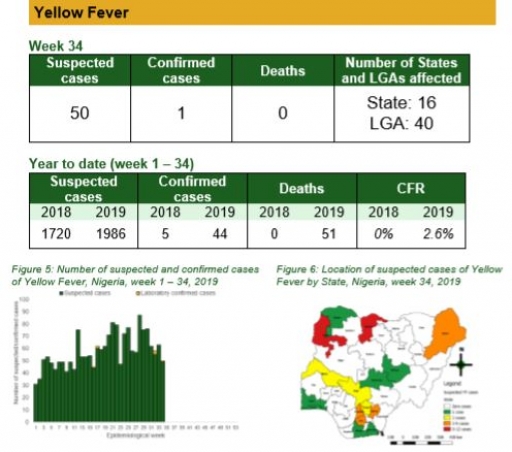
Cholera
Key points
There were 49 suspected cases of Cholera reported from three LGAs in Adamawa State (Girie – 6, Yola North – 34, Yola South - 9). There were 12 laboratory confirmed cases and no death was recorded
Actions
To date:
• The National Cholera TWG continues to coordinate activities in Adamawa state in collaboration with the Federal Ministry of Water Resources (FMWR) and support from partners
• Adamawa state EOC continues to coordinate response with support from partners
• Training of 19 Health care workers on Infection Prevention and Control (IPC) skills in Adamawa state
Planned:
• Engage private facilities on case management and reporting
• Conduct AAR from 26th- 27th September, 2019
• Follow up with states with active outbreak and monitoring of non-reporting states.
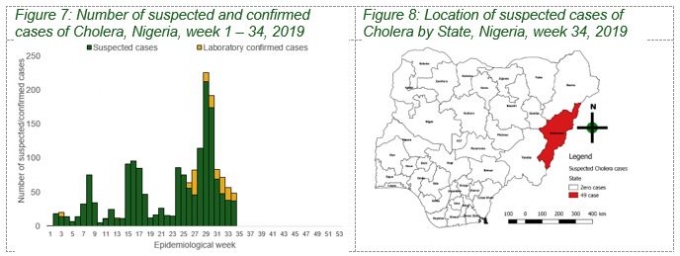
Measles
Key points
• There were 294 suspected cases of measles reported from 120 LGAs in 26 States and FCT. None was laboratory confirmed and no death was recorded
Actions
To date:
• The multi-agency National Measles TWG is monitoring and coordinating response activities across the states
• The TWG is working closely with NPHCDA towards Measles Supplemental Immunization Activity in Nigeria
Planned:
• Continue review of measles surveillance data across the country
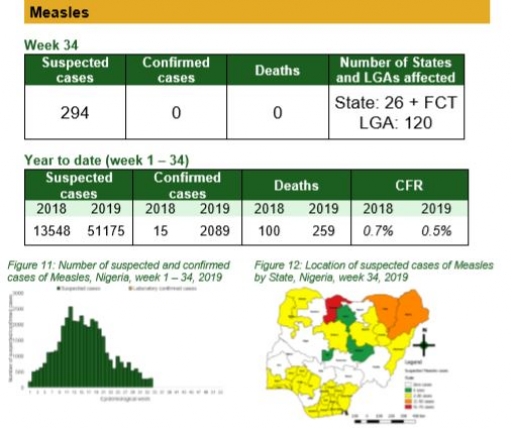
Monkeypox
Key points
• There was no suspected case of Monkeypox reported this week
Actions
To date:
• The Monkeypox TWG is monitoring and coordinating response activities across the states
• Surveillance has been enhanced in all states
Planned:
• Visit to non-reporting states in North-Central, South-East, South-West and South-South zones
• Conduct regional Monkeypox surveillance training in South-East and South-South Zone in September 2019
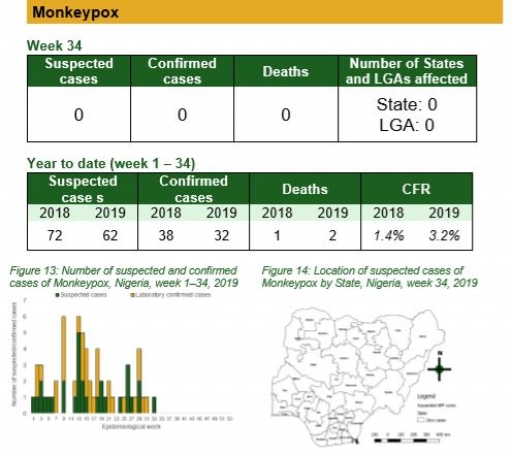
Acute Flaccid Paralysis (AFP)
Key points
• In the reporting week, 70 suspected cases of AFP were reported from 63 LGAs in 27 states and FCT.
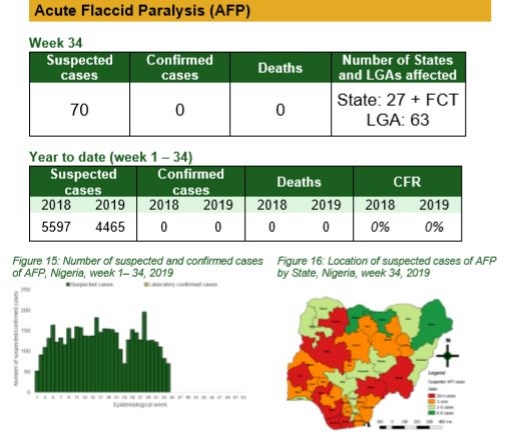
National Influenza Sentinel Surveillance
Key points
• There was a positive case of Influenza subtype A & B (0.3%)
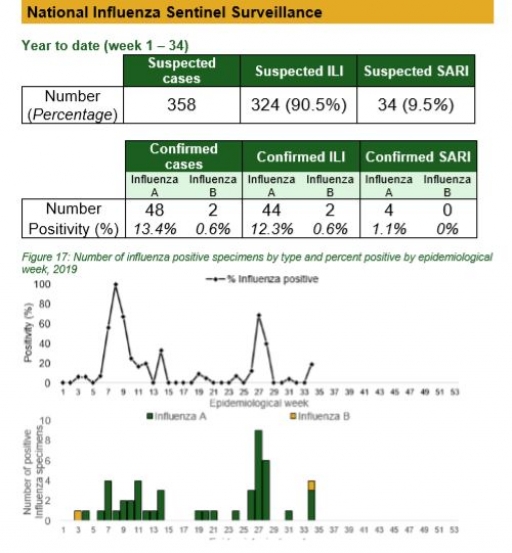
Timeliness and Completeness of Reports

Timeliness and Completeness of Reports by State
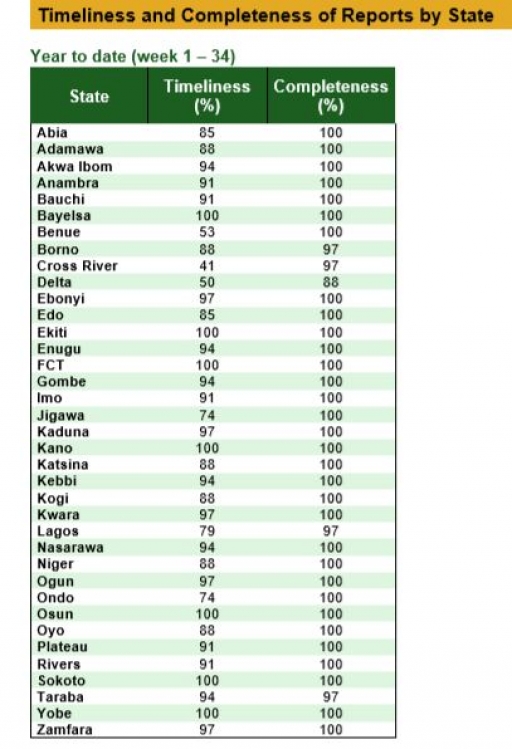













 Toll Free Number: 6232
Toll Free Number: 6232 Whatsapp: +234 708 711 0839
Whatsapp: +234 708 711 0839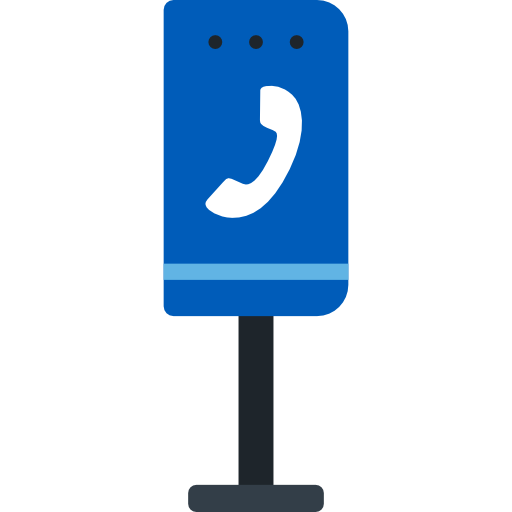 SMS Number: +234 809 955 5577
SMS Number: +234 809 955 5577 